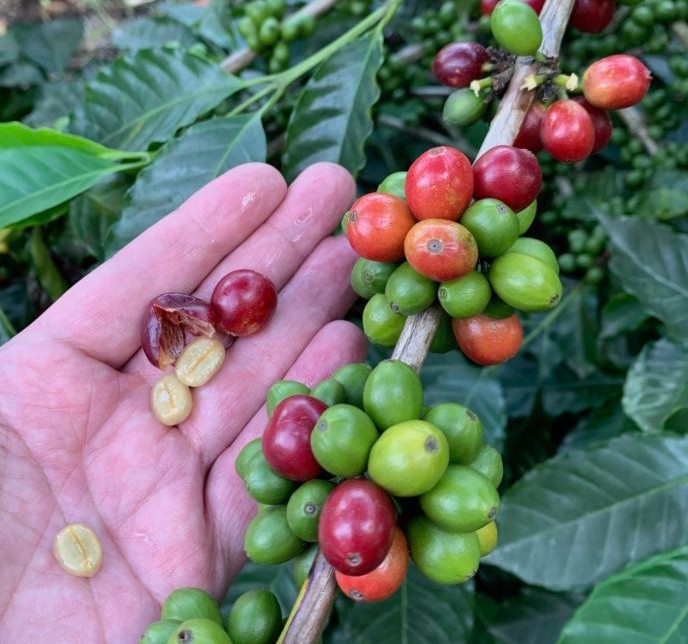Coffee grounds cover a lot of ground
Fresh, spent grounds have various uses in gardening, housekeeping, self-care, more
While there are uses for organic waste from every level of the coffee chain, the variety of uses for fresh and spent grounds seem to be limited only by the imagination, said Texas A&M AgriLife experts.

Coffee grounds going to ground
Probably the most popular and practical use of spent coffee grounds is as a garden soil amendment and for composting.
“Used coffee grounds can add a small amount of nitrogen to your soil or compost,” said Daphne Richards, Texas A&M AgriLife Extension Service horticulturist for Travis County. “You can add the grounds directly onto the soil, as long as you are careful not to create a thick crust. Better yet, fold the coffee grounds a couple of inches down into the soil or add them with other organic material for your compost.”
She said adding spent coffee grounds to the soil will improve its structure in both the short and long term. She also noted their usefulness in composting is especially effective because their high carbon-to-nitrogen ratio makes it unnecessary to put any additives into the mix.
“Only a small percent of the nitrogen found in coffee grounds can be used by plants immediately,” she said. “Then over time, microorganisms break down the organic matter, converting the suspended nitrogen into a useable form. This creates a steady, slow nitrogen supply for your plants. It also helps retain soil moisture.”
Coffee grounds contain the three major nutrients plants and grasses need to thrive —nitrogen, phosphorus and potassium, said Ben Wherley, Ph.D., Texas A&M AgriLife Research turfgrass ecologist in Texas A&M’s Department of Soil and Crop Sciences. They also contribute minor amounts of important micronutrients such as magnesium, copper and calcium, which are not typically found in synthetic fertilizers.

Wherley and others have been investigating the use of coffee grounds as a supplement for turf grass on lawns, sports fields and golf courses.
“We found that spent coffee grounds may have potential not only to improve existing fertilizer performance, but may also rival peat moss as a viable organic matter amendment,” he said.
Other well-grounded uses
Besides the garden, coffee grounds have a number of uses in the home and for self-care. Some of these uses include:
— Odor neutralizer. Coffee grounds can help absorb and eliminate odors. Placing an open container of coffee grounds in the refrigerator or freezer can help neutralize odors from spoiled or smelly foods. Coffee grounds in an arable holder like a cloth bag or old sock can help deodorize a gym bag or laundry hamper. A bowl or container of used coffee grounds kept near the sink can also be used to help remove strong food odors from hands.
— Household cleaning scrub. The sturdy and abrasive qualities of coffee grounds make them useful as a scrub for hard-to-clean surfaces. They can also help remove buildup on sinks and kitchen utensils as well as remove caked-on food from cookware.
— Exfoliating scrub. Those same coarse spent coffee particles work as an exfoliant to help remove dirt and dead skin cells. Mix the grounds with water and some coconut oil and apply the mixture directly to your face and body.
— Natural dye. Wet coffee grounds produce an all-natural dye for coloring cotton, linen rayon and other materials, plus it can give them an older or vintage look. Coffee grounds can also be used as a dye for darker hair or for coloring Easter eggs.
Some artists also use the dye in water-color paintings to give them a look similar to that of an old sepia-tone photograph.”
— Furniture renewal. If a piece of wood furniture, say a coffee table, has a small scratch or unsightly scuff mark on it, you can disguise it with a mixture of coffee grounds and olive oil. Take one tablespoon of coffee grounds and mix with one teaspoon of olive oil, then apply the mixture with a cloth, cotton swab or cotton ball and wipe dry.
— Cosmetic purposes. While tea bags have long been used as a home treatment for dark circles under the eyes, spent coffee grounds may be just as effective. Coffee grounds contain antioxidants and caffeine, which help prevent the appearance of aging and help shrink under-eye circles. Add water or coconut oil to spent coffee grounds and apply the mixture under the eyes. Wait 5 to 10 minutes and then rinse it off.
— Cooking. Coffee grounds can be used as a meat tenderizer because they contain natural acids and enzymes that help soften the meat. Add a few tablespoons of used coffee grounds to your favorite dry rub and apply it two hours before cooking. The grounds will also give the meat a dark, crisp crust as it cooks. And using instant coffee grounds or brewed coffee instead of water in recipes for foods such as chocolate cakes and chili can enhance their flavor.
Wizzie Brown, AgriLife Extension entomologist, Travis County, noted that while many websites indicate coffee grounds can be used as an insect repellent, that may not be entirely accurate.
“Molly Keck, the AgriLife Extension entomologist for Bexar County, and I did some yard trials to see what effect coffee grounds may have as a fire ant repellent, but they had little or no effect. However, the grounds may contain some compounds or have a smell some insects don’t like, and that may help keep them away.”

Other ways coffee ‘leftovers’ are reused
While coffee is not grown to a large extent in the U.S., Rodrigo Chavez, coffee training and program director at the Center for Coffee Research and Education, part of the Borlaug Institute for International Agriculture at Texas A&M University in Bryan-College Station, was formerly a coffee grower in Guatemala. He said some organic waste is recycled or repurposed at almost every step of the coffee production process.
“Once the cherry is plucked from the coffee tree, the shell or ‘cascara’ needs to be removed to expose the bean,” Chavez said. “And during the drying process, there is a husk that needs to be removed from the bean. Both are organic materials frequently used in compost on the coffee farm.”
He also noted the coffee cascara, once dried and processed, can be sold at a higher price than the coffee itself for a variety of uses from tea-like infusion to making flour for cooking.
Chavez said branches cut from coffee trees during pruning, along with other organic material derived from processing the coffee at the farm level, also can be shredded into compost material or turned into biochar for use as a soil amendment.
“I know some people have extracted oils from spent coffee grounds and used them in the production of biodiesel,” he said. “I’ve also seen where spent coffee grounds are mixed in with polymers to make household items like coffee cups and plates. There are also briquettes and fireplace logs made with spent coffee grounds.”
Other innovative products being made using fresh or spent coffee grounds as a component include soaps, face creams, yarn and fabrics, lamps, printing ink and furniture.


